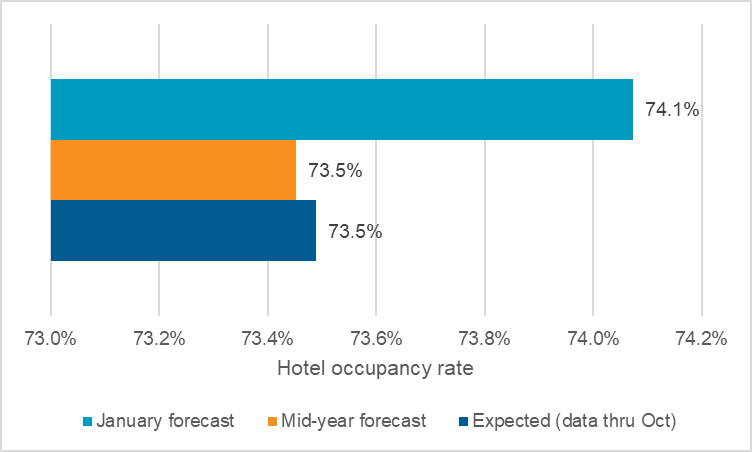Following the pandemic, travel seemed to undergo a fundamental shift with the rise of “revenge travel” and the emergence of the digital nomad who could take advantage of traveling without having to take time off from work. In 2022, overnight travel was certainly “vengeful,” with hotel visitors staying an average of four (4) nights and short-term vacation rental (STVR) visitors, such as those using Airbnb and Vrbo, spending 5.3 nights.
This represented a significant departure from 2019 when hotel visitors stayed an average of 3.1 nights and STVR travelers stayed for an average of 4.4 nights. Moreover, overnight visitors comprised 60% of travelers to San Diego in 2022 veering from the usual 50-50 split seen between day trippers and overnighters before the pandemic.
These changes in traveler behavior made 2023 an especially difficult year to forecast. Would these new post-pandemic behaviors persist, or would they revert to “normal?” Complicating matters, adverse weather and persistent fears for a (yet to be realized) recession added even more uncertainty to the forecasting process. (More on these topics here as well.)
Now that we have nearly a full year’s data in hand, things are becoming clearer. Obviously, this helps to clarify 2023, but it also provides guidance for what might be in store for 2024.
Visitation & Spending
Total visitation for 2023 is expected to reach 31.4 million people by year-end now that we have data through October, right in the middle of the January forecast of 31.8 million and the mid-year forecast of 31.0 million.

Visitor spending is tracking a bit closer to the mid-year forecasts at about $14.3 billion. However, it looks like STVR visitors are spending a little more freely than what was forecasted several months ago. It’s also worth noting that $14.3 billion would be a fresh record after 2022’s $13.6 billion haul.

Combining those points, average spending per visitor is tracking lower than the January and mid-year forecasts for each of these cohorts except for STVR visitors.

Hotel Sector
A weak spring season led to downgrades to the 2023 room night demand forecast from 17.5 million as of the January forecast to 17.2 million in the July projections. Through October, we’re tracking right on top of the mid-year forecast.

Occupancy is also tracking the mid-year forecasts closely.

Average daily rates (ADR) have been a bright spot. The return of business and convention activity has kept ADR higher amid somewhat lackluster leisure demand. ADR is on track to finish 2023 $10 higher than the January forecast, and revenue per available room (RevPAR) is closing in at $7 above the January forecast.


Taken together, hotel revenues are on track to come in at or above mid-year forecasted levels.

Looking Ahead
So, does 2023 provide any context for what we can expect in 2024? Well, yes and no. The past year has shown that some of the extraordinary changes in traveler behavior in 2022 are starting to slowly revert to pre-pandemic norms while other trends persist. Economic and financial uncertainty also remains high. However, the shifts are more positive than not.
On the upside, hotel lengths of stay are on track to finish 2023 at nearly 3.9 nights—well above pre-pandemic averages—and STVR lengths of stay are holding at around 4 nights, a drop from 2021 and 2022 but enough to continue to drive economic impact. It seems unlikely that lengths of stay will immediately drop in 2024, which will help to keep per-trip expenditures by overnight visitors elevated.
The return of the long-haul domestic traveler has helped to continue the trend toward longer lengths of stay. After a hiatus during and immediately following the pandemic, travel to San Diego from nearly every other part of the country resumed in 2023. People from longer-haul travel markets tend to stay longer and spend more than those from nearby places like Los Angeles and the Inland Empire, which should make 2024 a good year for regional hotels. Moreover, travel from countries like Canada and the UK is helping to maintain a floor under lengths of stay and spending.
That said, day visitors have made up a larger share of travelers to San Diego so far in 2023 than in 2022, swinging the mix back to the historical 50-50 split between day trippers and overnight visitors. This could skew visitor spending lower than projected, since day trippers don’t spend as much per trip as overnight travelers, although longer lengths of stay will offset this if maintained.
A key downside risk is that it’s highly uncertain whether travelers will be able to shoulder high travel costs in 2024 like they did in 2022 and 2023. Hotels are expected to hold their rates to deal with higher business costs, but that may come at the expense of occupancy. While there are no signs that ADR cuts are necessary now, it is possible that some concerns may begin to appear by mid-2024, meaning we will have to stay agile when forecasting the next couple of years.
On balance, however, 2024 is shaping up to be a better year than 2023 in almost every regard. Recession fears are subsiding, inflation has cooled significantly, and inflation-adjusted incomes are improving as a result amid steady job gains across the U.S., which should help travelers handle higher airfares and room rates. One particularly important post-pandemic trend also appears likely to persist with us: the necessity of travel for personal well-being, and that is good news for everyone, including San Diego.
Leave a Reply